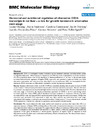Identificador persistente para citar o vincular este elemento:
https://accedacris.ulpgc.es/handle/10553/48255
| Título: | Hormonal and nutritional regulation of alternative CD36 transcripts in rat liver - A role for growth hormone in alternative exon usage | Autores/as: | Cheung, Louisa Andersen, Malin Gustavsson, Carolina Odeberg, Jacob Fernández-Pérez, Leandro Norstedt, Gunnar Tollet-Egnell, Petra |
Clasificación UNESCO: | 32 Ciencias médicas 3201 Ciencias clínicas |
Palabras clave: | Fatty-Acid Translocase/Cd36 Activated Receptor-Alpha Binding-Protein Skeletal-Muscle Gene-Expression, et al. |
Fecha de publicación: | 2007 | Proyectos: | Mecanismos Moleculares y Celulares de Señalización Intracelular en Respuesta A la Hormona de Crecimiento Humana: la Vía Jak (Janus Kinase) Stat (Signal Transducer And Activator Of Transcription) Co | Publicación seriada: | BMC Molecular Biology | Resumen: | Background: CD36 is a multiligand receptor involved in various metabolic pathways, including cellular uptake of long-chain fatty acids. Defect function or expression of CD36 can result in dyslipidemia or insulin resistance. We have previously shown that CD36 expression is female-predominant in rat liver. In the present study, hormonal and nutritional regulation of hepatic CD36 expression was examined in male and female rats. Since alternative transcription start sites have been described in murine and human Cd36, we investigated whether alternative CD36 transcripts are differentially regulated in rat liver during these conditions. Results: Sequence information of the rat Cd36 5′-UTR was extended, showing that the gene structure of Cd36 in rat is similar to that previously described in mouse with at least two alternative first exons. The rat Cd36 exon 1a promoter was sequenced and found to be highly similar to murine and human Cd36. We show that alternative first exon usage is involved in the female-predominant expression of CD36 in rat liver and during certain hormonal states that induce CD36 mRNA abundance. Estrogen treatment or continuous infusion of growth hormone (GH) in male rats induced CD36 expression preferentially through the exon 1a promoter. Old age was associated with increased CD36 expression in male rats, albeit without any preferential first exon usage. Intermittent GH treatment in old male rats reversed this effect. Mild starvation (12 hours without food) reduced CD36 expression in female liver, whereas its expression was increased in skeletal muscle. Conclusion: The results obtained in this study confirm and extend our previous observation that GH is an important regulator of hepatic CD36, and depending on the mode of treatment (continuous or intermittent) the gene might be either induced or repressed. We suggest that the effects of continuous GH secretion in females (which is stimulatory) and intermittent GH secretion in males (which is inhibitory) explains the sex-different expression of this gene. Furthermore, a female-specific repression of hepatic CD36 in response to food deprivation was found, which was in contrast to a stimulatory effect in skeletal muscle. This demonstrates a tissue-specific regulation of Cd36. | URI: | https://accedacris.ulpgc.es/handle/10553/48255 | ISSN: | 1471-2199 | DOI: | 10.1186/1471-2199-8-60 | Fuente: | BMC Molecular Biology,v. 8 (60) |
| Colección: | Artículos |
Citas SCOPUSTM
39
actualizado el 08-jun-2025
Citas de WEB OF SCIENCETM
Citations
40
actualizado el 08-jun-2025
Visitas
70
actualizado el 30-sep-2023
Descargas
36
actualizado el 30-sep-2023
Google ScholarTM
Verifica
Altmetric
Comparte
Exporta metadatos
Los elementos en ULPGC accedaCRIS están protegidos por derechos de autor con todos los derechos reservados, a menos que se indique lo contrario.
